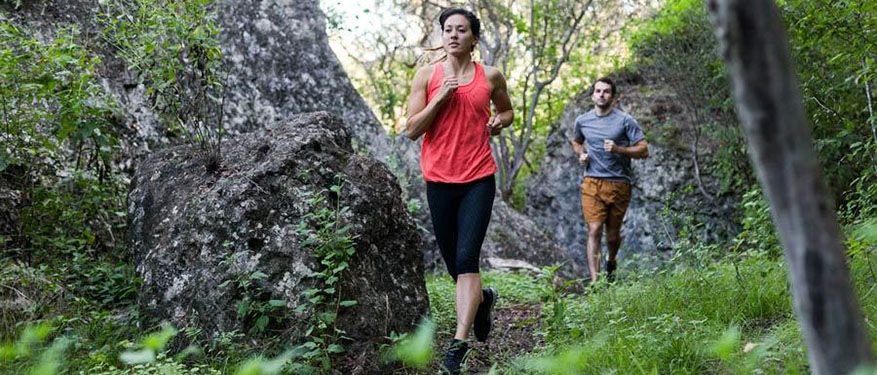Looking to ditch boring road running to explore rugged terrain? Here’s a beginner’s guide to the world of trail running.
Whether you’re a seasoned road runner looking to mix up your routine or new to the sport altogether, trail running is a scenic way to exercise. Every trail run is a new adventure allowing you to discover hidden gems. Whether you plan to run the trails each day, or frequent local parks from time to time, trail running greatly benefits your mental and physical health. As with any new endeavor, follow these tips and tricks to get the most out of your time on the trails!
What to bring:
One of the best parts of running is that you don’t need a lot of gear to do it.
Going for a run can be as easy as lacing up your shoes, throwing on shorts and
a t-shirt, carrying a drinking vessel and heading out the door. While some runners
choose to stick to the basics, you can opt to add gear to make your run more
enjoyable, especially when you begin to explore rugged terrain.
Shoes:
Picking the right shoes can be crucial for a runner’s experience and not all pairs
are created the same. Road running shoes greatly differ from the shoes needed
to explore the trails. While there is not just one perfect shoe for trail running,
your pair must have good traction, protection and stability to traverse the unknown
of an off-road adventure.
Water Bottles:
Having water is a must for runs of any length and though having a bottle in hand
isn’t the most convenient, there are a lot of other easy options to stay hydrated.
Aside from water bottles, hydration packs, hydration vests and waist packs allow
for handsfree H2O without feeling weighed down. The amount of water you carry
depends on the length of your run. For shorter runs, waist packs are a go-to
for trail runners. Waist packs provide storage for a small bottle, keys, cash
and a small energy bar. For longer runs, consider a larger waist pack with more
storage for all the items you may need. In searching for an attachable water
source, make sure your vessel of choosing is comfortable and does not restrict
your arm movement.
 Clothing:
Clothing:
Though there is not a universal dress code for trail runners, some types of clothing
works better than others. Cotton shirts are a no-go, as perspiration from a long
run gets absorbed and can make you feel heavy. Wearing moisture-proof clothing
and wool or synthetic socks are the best option, especially for longer runs.
Depending on the length of your run, wearing layers can guarantee you are properly
dressed for the temperature changes. It’s important to consider the breathability
of your clothing, and not wear clothes that aren’t free flowing. Clothes that
are made of lightweight fabrics with zippers ensure that perspiration isn’t trapped
against your body.
Food and Fuel:
To endure the possibly troubling terrains ahead, it’s important to fuel your body
with foods that will keep you going. For shorter runs, energy bars and gels are
sufficient. For runs lasting longer than an hour, you’ll want to bring an assortment
of refueling tools. As your runs extend in length, you will need to experiment
with foods that provide enough energy, but don’t weigh you down. The pros suggest
carb and protein dense foods like sandwiches, peanut butter and protein bars.
Watches:
While your phone has many fitness tracking capabilities, it may not be the most
convenient or comfortable to hold a mobile device in your hand for the duration
of your run. Thankfully, recent advancements in fitness watches have allowed
for a lightweight alternative to track your activity. Every runner has their
preference, but any watch with GPS capabilities is a great option. Aside from
tracking direction, a GPS watch can track your mileage, your pace and laps. Apple,
Fit Bit and Garmin watches offer watches with a variety of capabilities, perfect
for any skill level.
Lights:
Most public parks are closed from dusk until dawn, but for trails that allow for
nighttime runs, lights are a must. Headlamps, light packs and other attachable
light sources ensure safety for the runner and other park users. As trail running
is met with many unknowns, wearing a light helps runners navigate the terrain
ahead.
Trail Etiquette and Safety:
Trail Etiquette:
Before hitting the trails, it’s important to note the unspoken “rules of the road.” One of the many benefits of trail running is the amount of scenic routes you will experience on your runs. Though, in order to keep the trails looking nice, if you need to refuel make sure you keep track of your wrappers and don’t litter. Trail running lends itself to unsteady and narrow terrains at times. In these instances, make sure to share the path. When approaching another runner, stay to the right and alert them so they have time to move over. You may encounter a cyclist or horse while on the trails. In these cases, it is safest for the runner to move to the side if the trail does not provide enough room for everyone.
Safety Measures:
When you’re on the trails, let a trusted person know where you are going and how
long you intend to be there. Getting lost on the trails can happen but is easily
preventable with proper safety measures. Make sure you are running on marked
trails, especially if it is your first time at a park or on a loop. A lot of
trail running paths are wooded or carve through a segment of trees. Wildlife
encounters are possible and can be dangerous if not handled correctly. In these
cases, it is important to make your presence known. Make a noise or clap your
hands so animals are less likely to supply a defensive reaction.
Technique:
For someone who is new to trail running, it may be a challenge to master your technique.
The best way to run on the trails is with your head up and eyes down, looking
at least ten steps ahead. A runner can encounter abrupt twists, turns and tree
debris on the trails. Staying focused allows you to best prepare for these challenges.
When obstacles present themselves, use your best judgement to pick the steadiest
path.
When approaching hills, it can be hard to maintain good running technique. Their
intimidating nature may cause you to prioritize getting to the top as quickly
as possible. Though, when charging a hill, take small and frequent steps. Maintain
a strong posture, keeping your back straight to ensure steady airflow. Super
steep hills can be daunting and hard to navigate. Don’t be afraid to take it
slow or walk if you need to.
After traversing difficult terrain on your run, include stretching into your trail
running routine. Even for an avid runner, trail running can be trying on your
arm and leg muscles as well as your core. Focusing on your most used muscles
can help to prevent soreness and injury in the future.
 Mindset:
Mindset:
Trail running is a challenging yet rewarding form of exercise. Time on the trails
allows for a scenic workout while also giving you space to find peace. Though,
it is important to note that trails can be rugged, which may impact your pacing.
This is normal, especially when you are used to running on flat terrain or new
to running as a whole. Do not let the numbers define or discourage you. Your
body is working hard and in a new way, so it’ll take some time to adjust to the
challenges of the trails.
With warmer weather in full swing, now is a great time to explore new ways to exercise
outdoors. While the world of trail running is untouched by many, West Virginia
has a wide array of scenic parks to explore by foot. Whether you’re a road runner
looking to spice up your weekly routine, or a running rookie seeking adventure,
trail running is a great way to get up and get moving. So go hit the trails,
you’ll be happy you did.